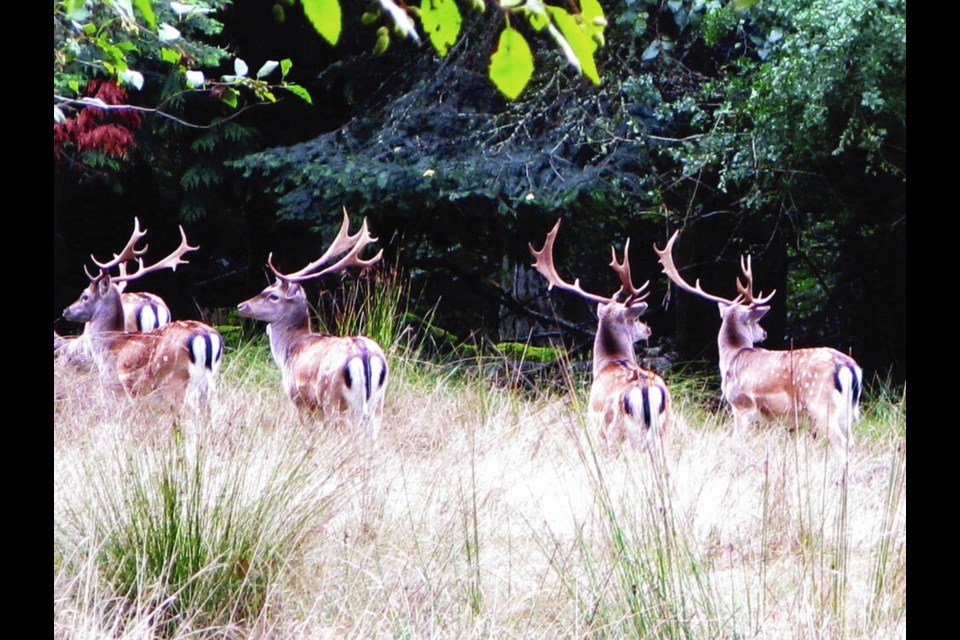Parks Canada is seeking public feedback on its planned cull of invasive European fallow deer on Sidney Island, which is expected to also eradicate the native black-tailed deer in the short-term.
The cull would involve two marksmen on the ground and two in a helicopter shooting as many fallow deer as possible over up to 10 days. A year later, any survivors would be flushed out, contained and shot using fencing and trained tracker dogs.
The cull, which would be undertaken by a company called Coastal Conservation, is part of a $5.9-million contract that would also see native plant species restored on Sidney Island.
This spring, Sidney Island property owners narrowly voted to move forward with the cull, with 52 per cent in favour of the move, although not all owners voted.
The owners, who own 1,500 hectares in 111 bare-land-strata lots, have long been split between favouring a mass kill and continuing to reduce the numbers of deer though seasonal hunting.
The current population of fallow deer is not known, but after years of culls and hunting, it has fallen from about 1,500 in the 1980s. A Parks Canada impact assessment report estimates current numbers at 300 to 900, and says they outnumber native deer.
The cull would also eradicate the small population of native black-tailed deer, which has been reduced on the island due to competition with European fallow deer, an impact assessment report says.
Kate Humble, superintendent of Gulf Islands National Park Reserve, said the native deer will be eradicated in the cull because it can be difficult to tell them apart from the invasive species and they can get caught up in herds with other deer.
Parks Canada says it expects the population will naturally re-establish on the island in the years or decades following the cull, but says if that doesn’t happen, it will facilitate reintroduction of the species, as long as all partners are in support.
Parks Canada has also created a management strategy to prevent a future over-population of black-tailed deer, as is seen elsewhere.
“The overall intention is for a restored forest ecosystem, which applies to all levels of ecosystems, from the plants, to the birds, to ungulates,” Humble said.
The removal of the deer will allow understory species to flourish, but it may also promote growth of undesirable invasive plant species, the impact assessment says.
Humble said the goal of asking for public feedback is not to determine whether the cull goes ahead but to get input on reducing negative impacts.
Eric Pelkey, hereditary chief of the Tsawout Nation and representative of the W̱SÁNEĆ Leadership Council, said the fallow deer have essentially eradicated important plants used for medicine, such as salmon berries, huckleberries and ferns.
Pelkey said the cull was initially a hard sell to his community, because eradicating animal life goes against the teachings of elders. “But I don’t think our people could still go on with the way the fallow deer are decimating the island,” Pelkey said.
He said black-tailed deer, which are hunted by his community, are “virtually gone” from the island, but he believes they’ll repopulate by swimming from nearby islands.
The Animal Alliance of Canada has questioned the method and basis for the cull.
Jordan Reichert, West Coast director for Animal Alliance of Canada, said shooting animals from a helicopter is less humane than hunting from the ground because the possibility for suffering is greater.
Reichert also questioned why non-lethal methods, such as immuno-contraception, weren’t tried first, and how a cull can go ahead without data on how many fallow deer exist on the island.
“When you have such a small population that’s isolated on an island, you know, that is a huge opportunity to utilize immuno-contraception and use it as this opportunity as a study for other areas, like they have in Oak Bay,” Reichert said.
The proliferation of fallow deer, which are thought to have been introduced on Sidney Island for hunting several times between the early 1900s and 1940s, has led to “a very, very bare forest understory,” said Humble.
“And if you go to some of the islands in the Gulf Islands that do not have an invasive deer population, you’ll see all of these wonderful, lush plants in the understory.”
Those plants provide traditional foods and medicines for First Nations communities, as well as habitat and food for animals in “a really rare ecosystem, the coastal Douglas fir ecosystem, which is very specific to this part of the world,” Humble said.
Sidney Island is the least biologically diverse island of the Southern Gulf Islands, Parks Canada says in the impact assessment report on the cull.
Public feedback can be provided until Aug. 23 via https://iaac-aeic.gc.ca/050/evaluations/document/152541.
>>> To comment on this article, write a letter to the editor: [email protected]



